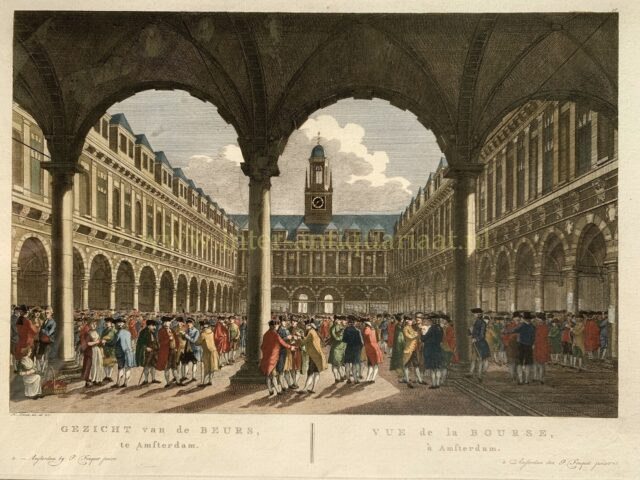Amsterdam stock exchange – Pierre Fouquet, 1783
THE OLDEST STOCK EXCHANGE IN THE WORLD “Gezicht van de beurs te Amsterdam“. Copper engraving published in 1783 by Pierre…
Read more
THE OLDEST STOCK EXCHANGE IN THE WORLD
“Gezicht van de beurs te Amsterdam“. Copper engraving published in 1783 by Pierre Fouquet Jr. based on a drawing by Herman Schouten from around 1765. Coloured by a later hand. Size (print): approx. 28 x 38.5 cm (image 23.2 x 35 cm).
In the early 17th century, the Amsterdam merchant exchange (Dutch: koopmansbeurs) was the most significant trading institution in the world. It quickly became a highly international affair, where all sorts of commodities were traded. Shares of the Dutch East India Company (VOC) were available for purchase, as well as futures contracts that granted the right to buy specified quantities of goods at a fixed price at a future date, insurances, and ordinary goods. Additionally, insurance contracts could be arranged, agreements concerning freight transport could be made, and information relevant to trade was readily available.
Construction of the exchange began in the spring of 1608, partly on the vaults of the lock across the Amstel river and partly on 50 to 60-foot-long piles.
The Amsterdam city council initiated the construction of this exchange to centralize trade within the city, which was beneficial for commerce and offered opportunities for regulation. The construction was overseen by city architect Hendrick de Keyser, and the design was modeled after similar exchange buildings in Antwerp and London. In 1611, the Merchant Exchange was completed.
The exchange consisted of a rectangular courtyard surrounded by a colonnade. Because it was partially built on bridge arches, ships with lowered masts could pass underneath. However, in 1622, this passage was closed off, initially with a beam in the waterway, then with heavy wooden doors, and finally, in 1672, it was permanently bricked up. The reason for the closure was attributed to a stonemason’s assistant from Namur named Balthasar Paul, who conspired to set Amsterdam on fire in 1622. One of his plans was to ignite the exchange. His plans failed, and Balthasar Paul ended his life on the gallows in Dam Square.
Possibly in 1611, but certainly after the renovation and expansion of the exchange in 1668, the stock exchange had a fixed place on the open-air trading floor.
While the majority of transactions on this exchange were related to the trade in goods, the exchange of Hendrick de Keyser was also the place where shares of the VOC and, from 1621, the Dutch West India Company were traded. Hence, this exchange building is considered the world’s oldest stock exchange.
To accommodate grain merchants, a separate exchange for grain was built in 1617 on the south side of the Oude Brug on the other side of the Damrak.
In 1835, the exchange had sunk so much that it had become unusable and was eventually demolished between 1836 and 1838. In its place, the Zocher exchange was built on the other side of Dam Square.
Price: SOLD




